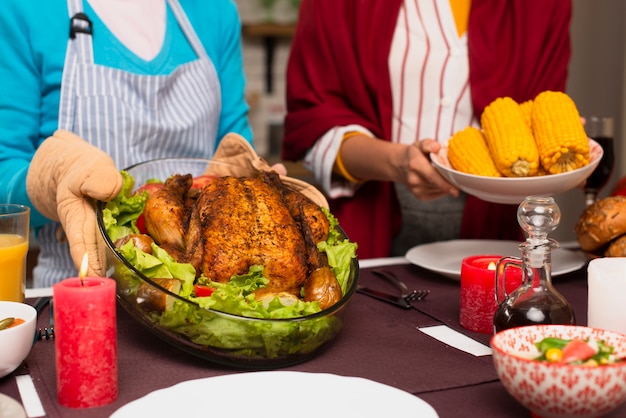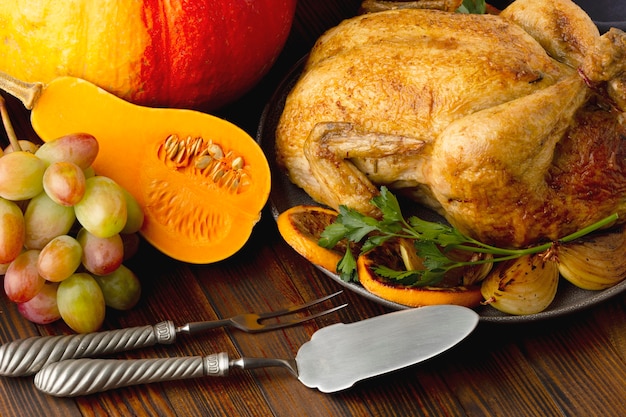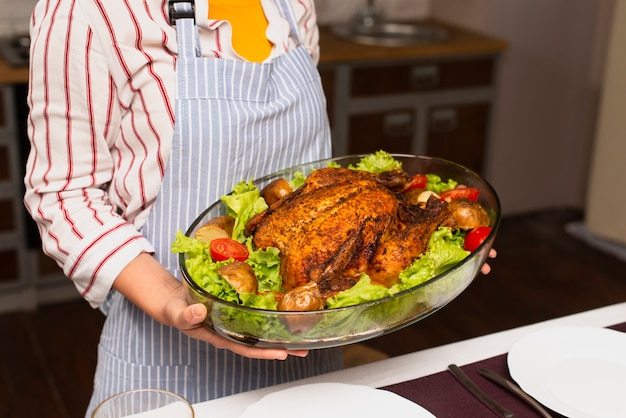So, you've got a 13lb turkey, a festive gathering on the horizon, and a whole lot of questions swirling in your head. Don't worry, you've come to the right place. I've been cooking turkeys for years now, from the humble student days with a small, supermarket-bought bird to those impressive feasts for extended family. There's a lot to consider, from the timings to the temperature to the best way to ensure a succulent and juicy bird. I'm going to break down everything you need to know, sharing some tips and tricks along the way. It's going to be a bit of a journey, but trust me, it's worth it. Let's get started!
(Part 1) Choosing Your Turkey: The Foundation of a Great Feast

The first step is picking the right bird. It's the foundation of your delicious feast, so it deserves some attention. I've always found that fresh is best, but a frozen turkey will do the job just fine. Just be sure to give it enough time to defrost – a 13lb bird can take a while! You don't want to be rushing around at the last minute trying to thaw a giant bird in the sink.
Fresh vs. Frozen: Weighing the Options
Fresh turkeys are often preferred for their flavour and moisture. They're typically available closer to the holidays, but they do require a bit more planning. Frozen turkeys, on the other hand, are readily available all year round and can be stored for longer. Just make sure you plan ahead and give yourself ample time to defrost the bird properly.
Looking for the perfect turkey
When choosing your turkey, make sure it’s plump and has a nice even colour. Avoid any with a strong odour or that have been sitting around for too long. A good butcher will be able to advise you on the best turkey for your needs. They can tell you about the different breeds available and help you pick a bird that's the right size for your gathering.
Brining: A Controversial Topic
Now, let's talk about brining. It's a bit of a divisive topic in the culinary world. Some people swear by it, claiming it makes the turkey incredibly moist and succulent. Others find it unnecessary and even a little bit messy. I'm in the "it's worth a try" camp. I like the extra moisture it adds, but it's not a deal-breaker for me. If you're going to brine, make sure to do it for at least 12 hours, and ideally for 24 hours. There are plenty of recipes online for both dry and wet brines. I find that a dry brine is less messy and just as effective. You can simply rub the turkey with salt and spices and let it sit in the refrigerator overnight.
(Part 2) Preparation: Getting Ready for Roast

Now, let's get down to business. You’ve chosen your turkey (brined or not), it's all prepped and ready to go. Next, it's time to prep it for roasting. This is where things get a bit more specific and you need to be careful. I've learned the hard way about these details. A little preparation goes a long way in ensuring a delicious and impressive turkey.
Pat It Dry
First, pat your turkey dry with paper towels. It's important to get rid of any excess moisture, as this will help the skin crisp up nicely. A crispy skin is essential for a truly delicious turkey. It adds a satisfying crunch and a beautiful golden-brown colour.
Seasoning: Herbs, Spices, and More
Next comes the fun part: seasoning! You can go simple with just salt and pepper, or get creative with your favourite herbs and spices. I like to rub the turkey with a mixture of garlic powder, onion powder, paprika, and thyme. It gives the turkey a warm, earthy flavour that complements the meat beautifully. You can also stuff the cavity with herbs, onions, and lemons for extra flavour. Just be sure to remove the stuffing before roasting, as it will cook unevenly and could potentially cause food poisoning.
Butter, Olive Oil, or Both?
Next, rub the turkey with some butter or olive oil. This will help the skin to brown nicely and also keep the meat moist. You can use either, or even a combination of the two. The choice is yours. Just remember that butter gives a richer flavour, while olive oil can contribute to a crispier skin. Personally, I like to use both! I start by rubbing the turkey with a mixture of olive oil and herbs, and then I add a layer of butter on top for extra richness.
(Part 3) Timing is Everything: The 13lb Turkey

Now, onto the crucial bit: cooking times. For a 13lb turkey, you're looking at roughly 3-4 hours of roasting time. That's a long time! And remember, this is just a general guide. You need to check the internal temperature of the turkey to ensure it's cooked through. But don't worry, I've got a table for you that will help.
The Turkey Cooking Time Chart
Here's a handy chart to guide you on the roasting times for a 13lb bird:
| Temperature (°F) | Time (Hours) |
|---|---|
| 325°F | 3-4 hours |
| 350°F | 2.5-3.5 hours |
Note that these are just guidelines. You'll want to check the internal temperature of the turkey to ensure it's cooked through. The USDA recommends an internal temperature of 165°F for the thickest part of the thigh and 180°F for the breast. You can use a meat thermometer to check this.
Factors Affecting Cook Time
There are several factors that can affect cooking time, including:
- The size of the turkey - a larger turkey will take longer to cook.
- The oven temperature - a higher oven temperature will cook the turkey faster.
- Whether you've brined the turkey - a brined turkey will cook more evenly and may require a shorter cooking time.
- Whether you've stuffed the turkey - stuffed turkeys generally require a longer cooking time to ensure the stuffing is cooked through.
Keep these factors in mind when calculating cooking time. Remember, it’s always better to err on the side of caution. You can always check the temperature again and roast for a little longer if necessary, but you can't uncook a turkey!
(Part 4) Checking for Doneness: Mastering the Meat Thermometer
Now, here's a little secret: I've been known to overcook a turkey in the past. I’ve got the horror stories to prove it. Dry, tough turkey is not a good look for anyone. Luckily, there's a simple tool that can help you avoid this culinary disaster.
The Meat Thermometer: Your Best Friend
A meat thermometer is your best friend when cooking a turkey. It's the only way to truly know if the turkey is cooked through. It might sound obvious, but it's easy to overcook the turkey without a thermometer. You'll want to check the internal temperature in the thickest part of the thigh. The turkey is cooked through when it reaches an internal temperature of 165°F.
How to Use a Meat Thermometer
Using a meat thermometer is simple. Just insert the probe into the thickest part of the thigh, making sure it doesn't touch any bone. Wait for a few seconds for the temperature to register and then read the result. If the temperature is below 165°F, continue cooking. If it's above 165°F, your turkey is ready to go!
(Part 5) Resting Time: Patience is Key
Now, don't be tempted to carve into your turkey straight away. Let it rest for at least 30 minutes, preferably covered in foil. This will allow the juices to redistribute throughout the meat, resulting in a more succulent and flavourful turkey. Trust me, it's worth the wait. It's a bit like a good bottle of wine, it just gets better with time.
Carving Time: Get Your Tools Ready
After the turkey has rested, it's time to carve. I like to use a sharp carving knife for this. I've learned that using a blunt knife can make a mess and makes the turkey look a bit unappetizing. It also makes it harder to slice the meat neatly. Have a carving fork handy to help you hold the turkey steady.
(Part 6) Leftovers: The Delicious Bonus
Now, let's be honest, you're probably going to have some leftovers. And that's a good thing! A turkey can provide so many delicious meals after the main event. I always get excited about the leftover turkey sandwich possibilities. You can make turkey salad, turkey soup, or even turkey tacos. The possibilities are endless!
Storing Leftovers Safely
To store your leftover turkey, let it cool down to room temperature before storing it in the fridge. It should last in the fridge for 3-4 days. You can also freeze leftovers for up to 2 months. Just be sure to thaw them properly in the fridge before reheating.
(Part 7) Top Tips for Success: Beyond the Basics
Now, let's talk about a few extra tips that can make a big difference. These are the ones I've picked up along the way, based on my own experiences.
1. Basting: A Touch of Moisture
I used to skip basting, thinking it wasn’t really necessary. But I’ve learned that it really does make a difference. Basting the turkey with pan juices helps to keep the meat moist and adds a lot of flavour. You can use a basting brush or just spoon the pan juices over the turkey. I recommend basting every 30-45 minutes during the roasting process.
2. Stuffing: The Controversial side dish
Now, let's talk stuffing. It's a classic Thanksgiving dish, but it can also be a bit controversial. As mentioned earlier, you shouldn't stuff the turkey while it's roasting, as it can lead to uneven cooking and food poisoning. It’s best to cook the stuffing separately in a baking dish. This way, you can ensure that the stuffing is cooked through and safe to eat.
3. Skin: Achieving That Perfect Crisp
If you want a crispy turkey skin, try this little trick: tuck the wings behind the turkey and place a piece of foil over the breast. This will help the breast to cook evenly and the skin will stay nice and crisp. You can remove the foil for the last 30 minutes of cooking to allow the skin to brown further.
4. The Perfect Temperature: Don't Overcook
Remember, the ideal internal temperature for a turkey is 165°F. Overcooking a turkey will result in dry, tough meat. So, check the temperature regularly and don't be afraid to take it out of the oven a little early if it's already cooked through. You can always cook it for a few more minutes if needed.
5. The Importance of a Roasting Rack
Using a roasting rack is a good idea, as it allows air to circulate around the turkey, which helps it to cook evenly. It also prevents the turkey from sitting in its own juices. However, if you don't have a roasting rack, you can simply place the turkey on a baking sheet. Just make sure to place a few vegetables underneath to prevent the turkey from sticking to the pan.
(Part 8) FAQs: Answering Your Questions
I know you've got questions. I've had them all too. So, let’s dive into the most frequently asked questions.
1. What if my turkey is smaller or larger than 13lbs?
Don’t worry, the cooking time chart is just a guide. The best way to determine cooking time is to check the internal temperature of the turkey. You can adjust the cooking time based on the size of your bird. For smaller turkeys, you'll need to cook them for a shorter time, and for larger turkeys, you'll need to cook them for a longer time.
2. Should I add other ingredients to the roasting pan?
Yes, you can add other ingredients to the roasting pan to add flavour to your turkey. I like to add onions, carrots, and celery. You can also add apples, oranges, or lemons. These vegetables will also release their juices into the roasting pan, creating a delicious gravy.
3. How do I make gravy?
Making gravy is easy. Simply pour off the pan juices into a saucepan and whisk in some flour. Bring the mixture to a boil, then reduce the heat and simmer for a few minutes, stirring constantly. Season to taste with salt and pepper.
4. Can I roast a turkey and a ham together?
Yes, you can roast a turkey and a ham together. Just make sure to place the ham on a separate roasting rack underneath the turkey. The ham will cook in the juices from the turkey, making it even more flavorful.
5. How long can I store a frozen turkey?
A frozen turkey can be stored for up to 12 months. Make sure to store it in the freezer at 0°F or below.
(Part 9) Enjoy Your Festive Feast!
There you have it! A comprehensive guide to roasting a 13lb turkey, from choosing the perfect bird to checking the temperature and making delicious gravy. Remember, the key is to plan ahead, follow the guidelines, and don't be afraid to experiment with different seasonings and flavours. With a little practice, you'll be a turkey roasting pro in no time! So, get your apron on, fire up the oven, and enjoy your festive feast!
Everyone is watching

Prime Rib Roast Cooking Time Chart: Per Pound Guide
Cooking TipsPrime rib roast. Just the name conjures images of lavish dinners, crackling fires, and hearty laughter. It’s ...

How Long to Bake Potatoes in the Oven (Perfect Every Time)
Cooking TipsBaked potatoes are a staple in my kitchen. They're incredibly versatile, delicious, and surprisingly easy to m...

Perfect Rice Every Time: The Ultimate Guide to Cooking Rice
Cooking TipsAs a self-proclaimed foodie, I've always been a bit obsessed with rice. It's the foundation of countless cuisi...

The Ultimate Guide to Cooking Asparagus: Tips, Techniques, and Recipes
Cooking TipsAsparagus. The mere mention of this spring delicacy conjures up images of vibrant green spears, crisp and burs...

Ultimate Guide to Cooking the Perfect Thanksgiving Turkey
Cooking TipsThanksgiving. Just the word conjures up images of overflowing tables laden with delicious food, the scent of r...
